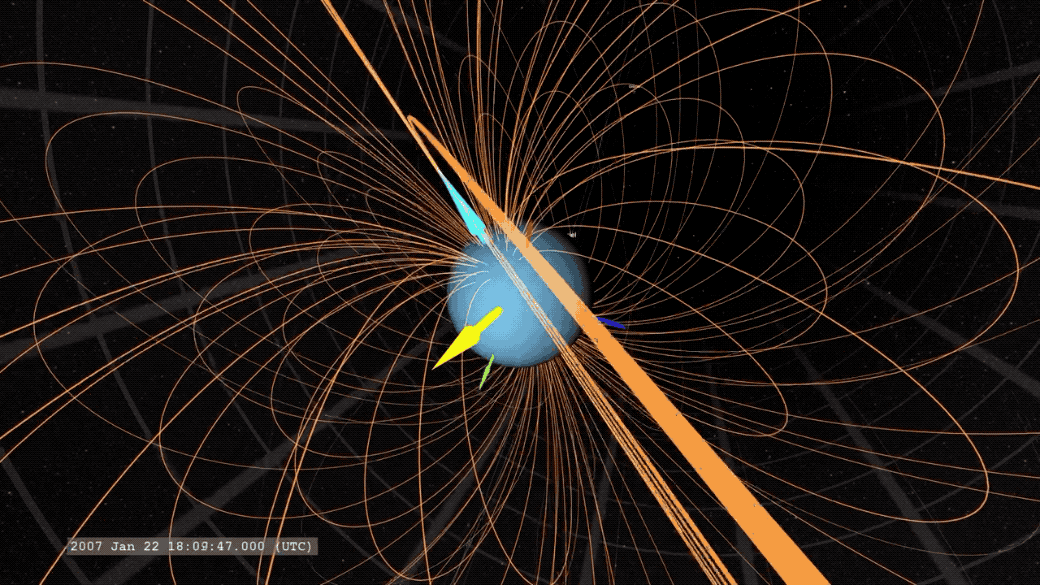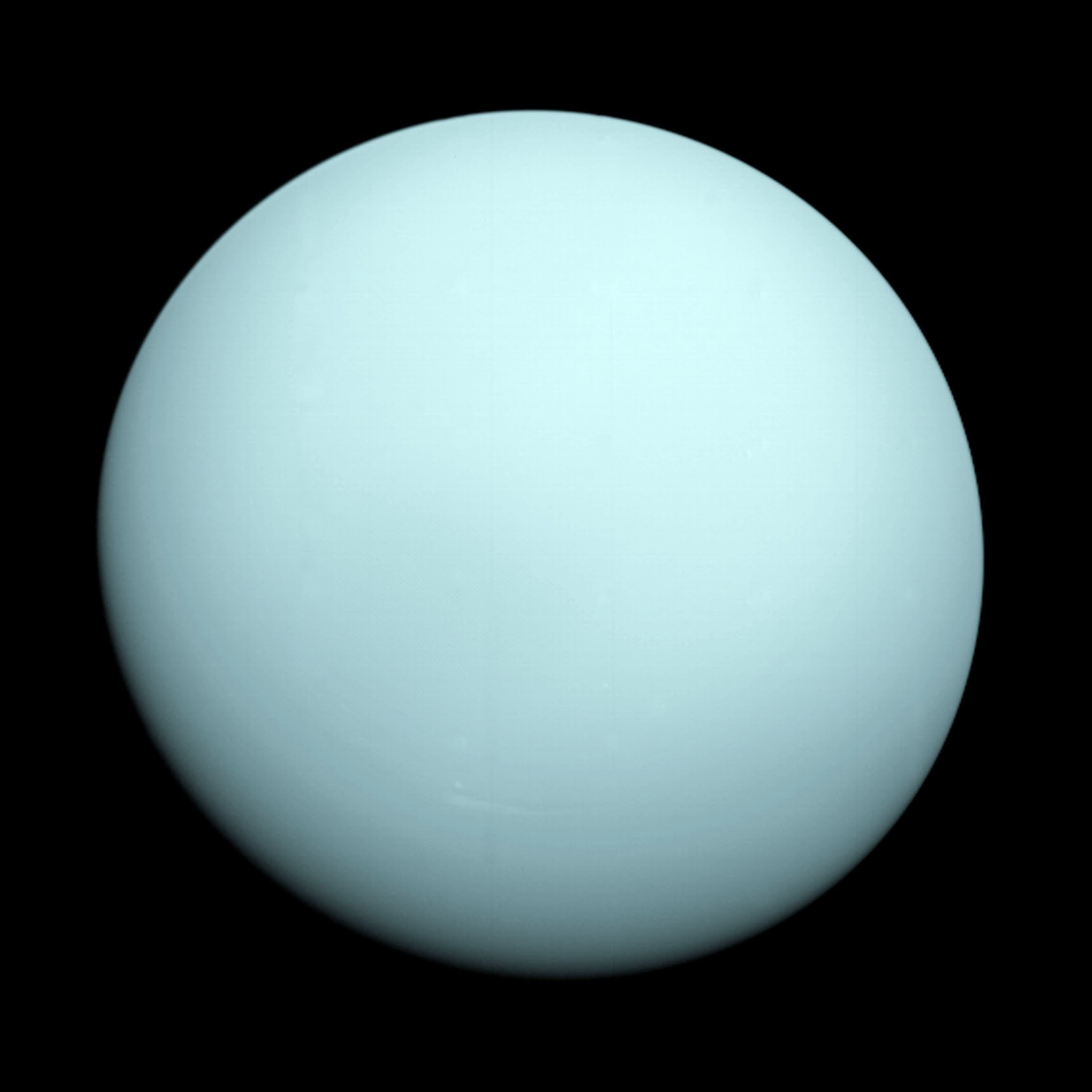Old gas blob from Uranus found in vintage Voyager 2 data

Buried inside data that NASA's iconic Voyager 2 spacecraft gathered at Uranus more than 30 years ago is the signature of a massive bubble that may have stolen a blob of the planet's gassy atmosphere.
That's according to scientists who analyzed archived Voyager 2 observations of the magnetic field around Uranus. These measurements had been studied before, but only using a relatively coarse view. In the new research, scientists instead looked at those measurements every two seconds. That detail showed what had previously been missed: an abrupt zigzag in the magnetic field readings that lasted just one minute of the spacecraft's 45-hour journey past Uranus.
The tiny wobble in the Voyager 2 data represents something much larger since the spacecraft was flying so fast. Specifically, the scientists behind the new research believe the zigzag marks a plasmoid, a type of structure that wasn't understood particularly well at the time of the flyby in January 1986.
Related: Photos of Uranus, the tilted giant planet
But by now, plasmoids have earned scientists' respect. A plasmoid is a massive bubble of plasma, which is a soup of charged particles. Plasmoids can break off from the tip of the sleeve of magnetism surrounding a planet like a teardrop.
Scientists have studied these structures at Earth and nearby planets, but never at Uranus or its neighbor Neptune, since Voyager 2 is the only spacecraft to date ever to visit those planets.
Scientists want to know about plasmoids because these structures can pull charged particles out of a planet's atmosphere and fling them into space. And if you change a planet's atmosphere, you change the planet itself. And Uranus' situation is particularly complicated because the planet rotates on its side and its magnetic field is skewed from both that axis and the plane all the planets lie in.
Get the Space.com Newsletter
Breaking space news, the latest updates on rocket launches, skywatching events and more!

Because Voyager 2 flew straight through this plasmoid, scientists could use the archived data to measure the structure, which they believe was about 250,000 miles (400,000 kilometers) across and could have stretched 127,000 miles (204,000 km) long, according to a NASA statement.
Ideally, scientists would piece together more observations of Uranus' magnetic field, enough to better understand how this phenomenon has shaped the planet over time. But that will require another spacecraft visit the strange sideways world.
The research is described in a paper published in August in the journal Geophysical Review Letters. NASA announced the finding on Wednesday (March 25).
- Uranus may have odd, strobe-like magnetic field
- Why is Uranus on its side? Incredible simulations could solve the mystery.
- How did Uranus form?
Email Meghan Bartels at mbartels@space.com or follow her @meghanbartels. Follow us on Twitter @Spacedotcom and on Facebook.
OFFER: Save at least 56% with our latest magazine deal!
All About Space magazine takes you on an awe-inspiring journey through our solar system and beyond, from the amazing technology and spacecraft that enables humanity to venture into orbit, to the complexities of space science.
Join our Space Forums to keep talking space on the latest missions, night sky and more! And if you have a news tip, correction or comment, let us know at: community@space.com.

Meghan is a senior writer at Space.com and has more than five years' experience as a science journalist based in New York City. She joined Space.com in July 2018, with previous writing published in outlets including Newsweek and Audubon. Meghan earned an MA in science journalism from New York University and a BA in classics from Georgetown University, and in her free time she enjoys reading and visiting museums. Follow her on Twitter at @meghanbartels.
-
dfjchem721 It has been postulated that the gas giants formed close to the sun and migrated out to their current positions. This seems counter intuitive from a simple gravitational perspective. How could large bodies form so close to each other and then separate instead of merge? Did a complex dance of gravitational forces between all these bodies prevent merging and lead to their separation?Reply -
rod Replydfjchem721 said:It has been postulated that the gas giants formed close to the sun and migrated out to their current positions. This seems counter intuitive from a simple gravitational perspective. How could large bodies form so close to each other and then separate instead of merge? Did a complex dance of gravitational forces between all these bodies prevent merging and lead to their separation?
dfjchem721, good question and perhaps a valid answer you offer. *Complex dance* is done in the computer simulations using various parameters like SPH or smoothed particle hydrodynamics, planetesimals, various accretion rates, and collisions as well as gas disk friction, etc. You would need to know if proto-gas giants were used too, very different in size and mass compared to the gas giants observed today in the ecliptic. In my personal studies, I see terms like NEO or NEA used. Near Earth Object or Near Earth Asteroid. I think I will start documenting NOO. Non-Observable Object used in computer simulations meaning objects in the past that are no longer seen in the ecliptic today that explains everything we see today in the solar system. I could extend this to quantum cosmology too. My point, there is heavy computational number crunching taking place with NOOs too for gas giant planet migrations used. -
dfjchem721 Thanks for the feedback, rod. I figured gravity was the only game for this, but it still seems a bit puzzling. I suppose it is possible that the sun ate a few of those "hopeful gas giants", leaving us with only four.Reply
I like your NOO. Non-Observable Object concept. (puts UFOs to shame!) How do you model that if the early sun ate some proto-gas giants?
Sorry for screwing up your starting post on Mercury cratering. After reading that article, went into hyper-drive on abiogenesis and forgot that you had started a thread and did not realize I had burned you on that. Also, I did not know how to respond to some of your commentary as you use a bit of shorthand I don't recognize. (Biochemist, as you might have guessed.)
Later I realized the LHB was late heavy bombardment, a subject I find fascinating but know little about. I assume the LHB resulted from all of the large debris left over from all the rocky accretions in the inner solar system that formed the four inner planets. Surely the earth was not the only rocky body to experience major collisions in the early years. There must have been an enormous debris field in the inner solar system before the current planets "cleared their zone", which I assume was largely complete by the end of the LHB.
Where can I find a brief on crater dating?
Dave -
rod Okay dfjchem721 (Dave), my name is Rod but the logon is rod I use. Biochemist is good. I am an amateur astronomy buff who observes using two telescopes and 10x50 binoculars. Math and vocabulary I find is the hard part of learning a discipline in science so the term, LHB I should have been clearer on.Reply
"Where can I find a brief on crater dating?"
My first suggestion is the NASA ADS Abstract system, https://ui.adsabs.harvard.edu/ Example, Destruction and Re-Accretion of Mid-Size Moons During an Outer Solar System Late Heavy Bombardment
There are many reports on crater dating methods too. Wikipedia has an article, Crater counting, "Crater counting is a method for estimating the age of a planet's surface. The method is based upon the assumptions that when a piece of planetary surface is new, then it has no impact craters; impact craters accumulate after that at a rate that is assumed known."
Some more recent reports indicated issues with crater rate counting for the LHB, Solar system acquired current configuration not long after its formation, and Dynamical evidence for an early giant planet instability "The dynamical structure of the Solar System can be explained by a period of orbital instability experienced by the giant planets. While a late instability was originally proposed to explain the Late Heavy Bombardment, recent work favors an early instability. Here we model the early dynamical evolution of the outer Solar System to self-consistently constrain the most likely timing of the instability. We first simulate the dynamical sculpting of the primordial outer planetesimal disk during the accretion of Uranus and Neptune from migrating planetary embryos during the gas disk phase, and determine the separation between Neptune and the inner edge of the planetesimal disk. "
I note from the Abstract, *migrating planetary embryos*. This fits my NOO description, at least in the ecliptic today :)---Rod -
dfjchem721 I think you are a tad beyond being an amateur astronomy buff, but if that is what you want to be called, so be it.Reply
On many things, I know enough to be dangerous. On life sciences, I know too much and frequently aggravate some of the masses with their moronic notions, most not worth dealing with. The creationists are the worst as you surely know. Happily, most of my science is at the bench - real empirical data. Modeling has to be pretty tough, and I bet there are a lot of hissy fits at meetings and in print about model designs and interpretations.
I have an old Celestron C-11 with PEC. It has served me well, especially with all the Televue optics i got with it. Bought it when their Binoview had just came out and had to buy two eyepieces each time. Well worth it, except balancing the weight could be a problem with the large eyepieces. Can't do without them.
*migrating planetary embryos*. Now that is something I have not heard of. Sounds wild! Will have to go over some of those links. So much complexity in all of this. -
rod Dave, the C-11 is a good telescope. I use Televue optics too. This week I received an e-mail from TeleVue that their doors are closed until further notice because of COVID-19, it is posted on their website too. I use a 90-mm refractor Vixen model (1991) with 1.25 inch focuser and a 10-inch, Orion XT10i Intelliscope on Dob mount that uses 2-inch and 1.25 inch focuser. I use a 2-inch eyepiece, TeleVue 35-mm PO - this is great especially with views of M31 and other galaxies! Here is another report on lunar crater dating, Ages of large lunar impact craters and implications for bombardment during the Moon's middle age "Standard lunar chronologies, based on combining lunar sample radiometric ages with impact crater densities of inferred associated units,"Reply
From what I understand, Apollo samples were radiometric dated and the lunar crater dating developed, extended to the rest of the solar system, this helped establish the LHB period, now apparently falling onto difficult times perhaps. You said "So much complexity in all of this". Yes, it is and math intensive modeling too using physics. Very logical but also assumptions and possible holes in the models too.
Dave, on the 31st next week (Tuesday morning), try and use your C-11 to view the close conjunction of Mars and Saturn in Capricornius. I have plans for observing near 0600 EDT and weather appears good - so far for my location. At 71x using a TeleVue 14-mm Delos, both planets should fit into the field of view showing Mars, small orange-red disk and Saturn, rings, and some of the moons. Someone with the astro photo equipment may get a great shot.
I am retired so getting out early in the morning or staying up all night looking at the starry sky is no problem for me. Enjoy that C-11 Dave when you can--Rod -
dfjchem721 Thanks for the info on Televue. So much is screwed up these days. I will have to get out my C-11. Have not used it in a while, last time viewing some large sunspots (quite a while ago). Always wanted to get a hydrogen alpha filter but did not want to drop that much cash. You have a nice assortment of viewing components.Reply
I also meant to ask you about the "Falkland Islands Anomaly", an apparently large impact crater that may have started the P/T mass extinction event. If I remember this correctly, it dates to 250-280 mya, but they do not have hard data like shocked quartz to confirm its nature. Wonder what your notions are on this and if any new data has become available. It is a big one if it caused the P/T ME. -
rod Dave, I know very little about the 'Falkland Islands Anomaly' and crater dating. I did find some reports though. Did a Planetary Society citizen scientist help find one of Earth’s biggest impact craters? "Michael Rampino, a geologist at New York University who now also works for NASA's Goddard Space Institute in New York, started looking for similar gravity anomalies elsewhere on Earth. He reasoned that a crater associated with the Great Dying would be even larger than that of Chicxulub, and he soon found one."Reply
Michael Rampino has a number of papers out on the NASA ADS system. https://ui.adsabs.harvard.edu/abs/2018IJEaS.107..601R/abstract, Geophysical evidence for a large impact structure on the Falkland (Malvinas) Plateau
The individual and authors appear to be working on it, do not know where the model stands though. It is a lovely afternoon where I am at now so heading out to enjoy some physical training and mountain bike riding. I am in a more rural area with horse and alpaca farms, large fields and plenty of woods.

